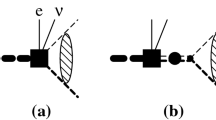Abstract
Our departure point in describing electromagnetic (EM) interactions with nuclei (in general, bound systems of charged particles) is to use the Fock-Weyl criterion and a generalization of the Siegert theorem. It is shown how one can meet the gauge invariance principle (GIP) in all orders in the charge and construct the corresponding EM interaction operators in case of nuclear forces arbitrarily dependent on velocity. Along the guideline we have derived the conserved current density operator for a dicluster system (more precisely, the system of two finite-size clusters with many-body interaction effects included). In the context, we are addressing the current clusterization as a first step when accounting for possible cluster excitations. Being expressed through the electric and magnetic field strengths and matrix elements of the so-called generalized electric and magnetic dipole moments of the system, associated with the conserved current, the single-photon transition amplitude attains a manifestly gauge-independent (GI) form. The latter is essentially simplified at low energies.
Similar content being viewed by others
References
V. V. Kotlyar, Yu. P. Mel’nik, and A. V. Shebeko, Phys. Part. Nucl. 26, 79 (1995).
Proceedings of the National Conference on the Theory of Few-Body and Quark-Hadronic Systems (Kharkov, 1992).
A. V. Shebeko, in Proceedings of the International Conference on the Theory of Few-Body and Quark-Hadronic Systems, Dubna, 1987, p. 426.
V. B. Belyaev et al., Phys. Rev. C 75, 034608 (2007).
V. Fock, Z. Phys. 39, 226 (1926).
H. Weyl, Theory of Groups and Quantum Mechanics (S. Hirzel, Leipzig, 1928; Dover, New York, 1931).
E. Kazes, T. E. Feuchtwang, P. H. Cutler, and H. Grotch, Ann. Phys. (N.Y.) 142, 80 (1982).
L. O’Raifeartaigh and N. Straumann, Rev. Mod. Phys. 72, 1 (2000).
J. D. Jackson and L. B. Okun, Rev. Mod. Phys. 73, 663 (2001).
R. G. Sachs and N. Austern, Phys. Rev. 81, 705 (1951).
L. G. Levchuk and A. V. Shebeko, Phys. At. Nucl. 56, 227 (1993).
A. Shebeko, Talk at the 20th International IUPAP Conference on Few-Body Problems in Physics, Fukuoka, 2012.
L. Levchuk, L. Canton, and A. Shebeko, Eur. Phys. J. A 21, 29 (2004).
A. Yu. Korchin and A.V. Shebeko, Sov. J. Nucl. Phys. 40, 708 (1984).
R. G. Sachs, Phys. Rev. 74, 433 (1948).
Mesons in Nuclei, Ed. by M. Rho and D. H. Wilkinson (North-Holland, Amsterdam, 1979).
G. R. Satchler, Direct Nuclear Reactions (Clarendon, Oxford, 1983).
L. Canton et al., Phys. Rev. C 74, 064605 (2006); K. Amos, L. Canton, G. Pisent, et al., Nucl. Phys. A 728, 65 (2003).
L. Canton, L. Levchuk, and A. Shebeko, Few-Body Syst. 44, 357 (2008).
Author information
Authors and Affiliations
Corresponding author
Additional information
I cordially dedicate this work to Vladimir B. Belyaev on the occasion of his 80th birthday
The text was submitted by the author in English.
Rights and permissions
About this article
Cite this article
Shebeko, A.V. Towards gauge-independent treatment of radiative capture in nuclear reactions: Applications to low-energy cluster-cluster collisions. Phys. Atom. Nuclei 77, 518–527 (2014). https://doi.org/10.1134/S1063778814040139
Received:
Published:
Issue Date:
DOI: https://doi.org/10.1134/S1063778814040139




